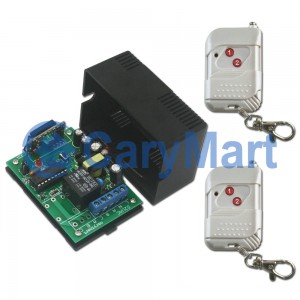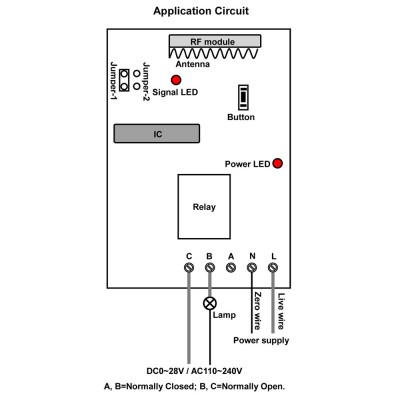We’d like to recommend one-to-many series remote control system: 15 channel remote control system (S15C-DC12 & 15C-1), which includes 15 transmitters and 1 receiver. The transmitter’s transmission distance is 100/300ft theoretically. This wireless gadget can remote control lights, TVs, motors, fans, cameras, video signals, audio signals, electrical operated doors/locks/windows/blinds/cars or other appliances with voltage of AC 110~240V or DC0~28V.


We’d like to show how to wire lamps and remote control lamps with this system.
The initial status is A,B normally open; B,C normally closed. We wire lamps to A&B terminals of each relay one by one. Next, we supply power to receiver. (Supply AC or DC power).

There are 15 working modes in it. We will try to show you the operation.
1) Learning Momentary control mode: When the receiver is in the status of LEARNING, press transmitter 1.
Control mode Momentary (Channel 1~15): Press and hold -> On; Release -> Off.
Press and hold transmitter 1: Turn on relay 1 (connect A and B, disconnect B and C)
Release transmitter 1: Turn off relay 1 (disconnect A and B, connect B and C)
…
Press and hold transmitter 15: Turn on relay 15 (connect A and B, disconnect B and C)
Release transmitter 15: Turn off relay 15 (disconnect A and B, connect B and C)
2) Learning Latched control mode: When the receiver is in the status of LEARNING, press transmitter 2.
Control mode Latched (Channel 1~15): Press -> On, other relays Off; Press other button -> Off.
Press transmitter 1: Turn on relay 1 (connect A and B, disconnect B and C)
Turn off other relays (disconnect A and B, connect B and C)
…
Press transmitter 15: Turn on relay 15 (connect A and B, disconnect B and C)
Turn off other relays (disconnect A and B, connect B and C)
3) Learning Toggle control mode: When the receiver is in the status of LEARNING, press transmitter 3.
Control mode Toggle (Channel 1~15): Press -> On; Press again -> Off.
Press transmitter 1: Turn on relay 1 (connect A and B, disconnect B and C)
Press transmitter 1 again: Turn off relay 1 (disconnect A and B, connect B and C)
…
Press transmitter 15: Turn on relay 12 (connect A and B, disconnect B and C)
Press transmitter 15 again: Turn off relay 12 (disconnect A and B, connect B and C)
4) Learning Momentary (Channel 1~8) + Latched (Channel 9~15) control mode: When the receiver is in the status of LEARNING, press transmitter 4.
5) Learning Toggle (Channel 1~8)) + Momentary (Channel 9~15) control mode: When the receiver is in the status of LEARNING, press transmitter 5l.
6) Learning Latched (Channel 1~8) + Toggle (Channel 9~15) control mode: When the receiver is in the status of LEARNING, press transmitter 6.
7) Learning Momentary (Channel 1~13) + Latched (Channel 14~15) control mode: When the receiver is in the status of LEARNING, press transmitter 7.
8) Learning Toggle (Channel 1~13) + Momentary (Channel 14~15) control mode: When the receiver is in the status of LEARNING, press transmitter 8.
9) Learning Toggle (Channel 1~5) + Momentary (Channel 6~10) + Latched (Channel 11~15) control mode: When the receiver is in the status of LEARNING, press transmitter 9.
10) Learning Momentary (Channel 1~5) + Latched (Channel 6~10) + Momentary (Channel 11~15) control mode: When the receiver is in the status of LEARNING, press transmitter 10.
11) Learning Toggle (Channel 1~2) + Momentary (Channel 3~10) + Latched (Channel 11~15) control mode: When the receiver is in the status of LEARNING, press transmitter 11.
12) Learning Momentary (Channel 1~2) + Toggle (Channel 3~10) + Latched (Channel 11~15) control mode: When the receiver is in the status of LEARNING, press transmitter 12.
13) Learning Latched (Channel 1~2) + Momentary (Channel 3~10) + Toggle (Channel 11~15) control mode: When the receiver is in the status of LEARNING, press transmitter 13.
14) Learning Toggle (Channel 1~2) + Latched (Channel 3~9) + Momentary (Channel 10~15) control mode: When the receiver is in the status of LEARNING, press transmitter 14.
15) Learning Toggle (Channel 1~13) + All On / Off (Channel 14/15): When the receiver is in the status of LEARNING, press butt transmitter on 15.
Press transmitter 14: Turn on all 15 relays
Press transmitter 15: Turn off all 15 relays

































